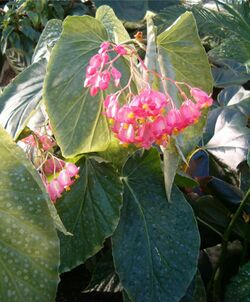Biology:Angel wing begonia
| Angel wing begonia | |
|---|---|
 'President Carnot' | |
| Genus | Begonia |
| Breeder | Eva Kenworthy Gray |
| Origin | California |
Begonia "Angel Wing" is a hybrid Begonia which resulted from a cross between Begonia aconitifolia and B. coccinea. The hybridization was made by California plant breeder Eva Kenworthy Gray in 1926.[citation needed] [1]
The Angel Wing Begonia resides within the Cane Group of Begonias, along with the Dragon Wing type which generally lacks variation on its leaves. Both Angel and Dragon are named for the shape of their leaves. Angel Wings generally contain spots or a frosted pattern. The underside is often a deep red. They flower and produce blooms that range in colors from red and pink to white.
Often, these plants are used as year-round houseplants. They're easy to grow for a gardener who understands their needs. Since begonias originated in the tropics, the ideal growing conditions include high humidity, good circulation of the air around the plant, a lot of water, and a lot of light. The more light, the more brilliant the color of the leaves.
Angel Wing Begonias will grow well under shade cloth, lattice, or in early morning/late afternoon sun. They will burn if grown in direct mid-day sun. The flowers are edible, with a sweet tart taste.
To propagate them, cut a two-leaf section of stalk 4 to 6 inches (10 to 15 cm) from the end using a sharp knife. Peel off the lower leaves, dip in rooting powder, and insert 2 inches (5.1 cm) into potting soil. Moisten with a watering can. After a few days, tug gently on the plant. If it holds, it has grown new roots. Transfer to a larger, regular pot.[2] Can also be started in water until roots grow and then planted.
References
- Conover, C.A. (1994). Angel-Wing Begonia Growth and Water Requirements Affected by Paclobutrazol. University of Florida. http://mrec.ifas.ufl.edu/Foliage/Resrpts/rh_94_4.htm. Retrieved 2007-06-11..
External links
- Plant Profiles: Angel-wing Begonia a "heavenly" plant, Chicago Botanic Garden
- BEGONIACEAE - BEGONIA FAMILY, Aggie Horticulture

